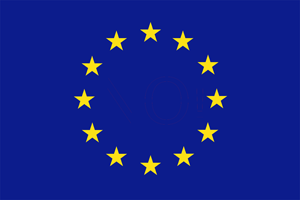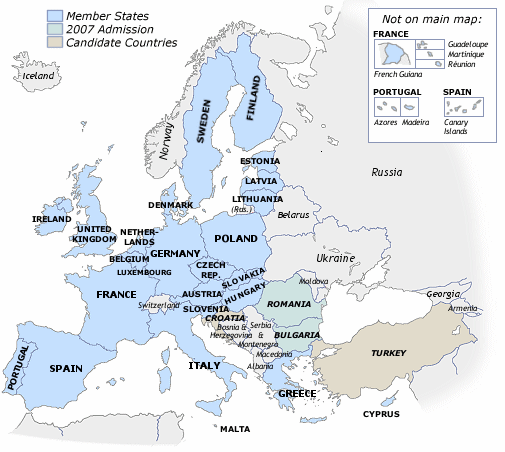 |
usa | world | animals | vocabulary | health | science | math | history |
European Union
The European Union or EU is, in part, an inter-governmental and supra-national organisation, made up of European countries, which currently has 25 member states. The Union was established under that name by the Treaty on European Union (commonly known as the Maastricht Treaty) in 1992. However, many aspects of the EU existed before that date through a series of predecessor organisations, dating back to the 1950s.

Flag of the European Union
There are 3 main institutions: The Council of the European Union, the European Parliament, and the European Commission. Each has a President, and each has a specific role and responsibility.
The European Union's activities cover all policy areas, from health and economic policy to foreign affairs and defence. However, the nature of its powers differs between areas. Depending on the powers transferred to it by its member states, the EU therefore resembles a federation (e.g. monetary affairs, agricultural, trade and environmental policy), a confederation (e.g. in social and economic policy, consumer protection, internal affairs), or an international organisation (e.g. in foreign affairs). A key activity of the EU is the establishment and administration of a common single market, consisting of a customs union, a single currency (adopted by 12 of the 25 member states), a Common Agricultural Policy and a Common Fisheries Policy.
On 29 October 2004, European heads of government signed a Treaty establishing a Constitution for Europe, which has been ratified by ten member states and is currently awaiting ratification by the other member states. However, this process faltered on May 29, 2005 when the people of France voted "non" in a referendum on the Constitution. This forced a change of Prime Minister in France. Their 'non' was followed three days later by a Dutch 'nee' on June 1st when the Netherlands voted against it as well.

Map of European Union Member States
European Union law comprises a large number of overlapping legal and institutional structures. This is a result of its being defined by successive international treaties. In recent years, considerable efforts have been made to consolidate and simplify the treaties, culminating with the final draft of the Treaty establishing a Constitution for Europe. If this proposed treaty is adopted, it will replace the set of overlapping treaties that form the current constitution of the EU with a single text.
The term European Community (or Communities) was used for the group of members prior to the establishment of the European Union. At present, the term continues to have significance, but in a different context. The "European Community" is one of the three pillars of the European Union, being both the most important pillar and the only one to operate primarily through supranational institutions. The other two pillars – Common Foreign and Security Policy, and Police and Judicial Co-operation in Criminal Matters – are looser intergovernmental groupings. Confusingly, these latter two concepts are increasingly administered by the Community (as they are built up from mere concepts to actual practice).
What most people think of as the European Union is essentially the European Community. The Community is an actual body, including the European institutions (European Parliament, Council of the European Union, European Commission), whilst the European Union is a less tangible grouping of institutions and agreements.
If it is ratified, the proposed new Treaty establishing a Constitution for Europe would abolish this dual structure, bringing all the Community's activities under the auspices of the European Union and transferring the Community's legal personality to the Union.